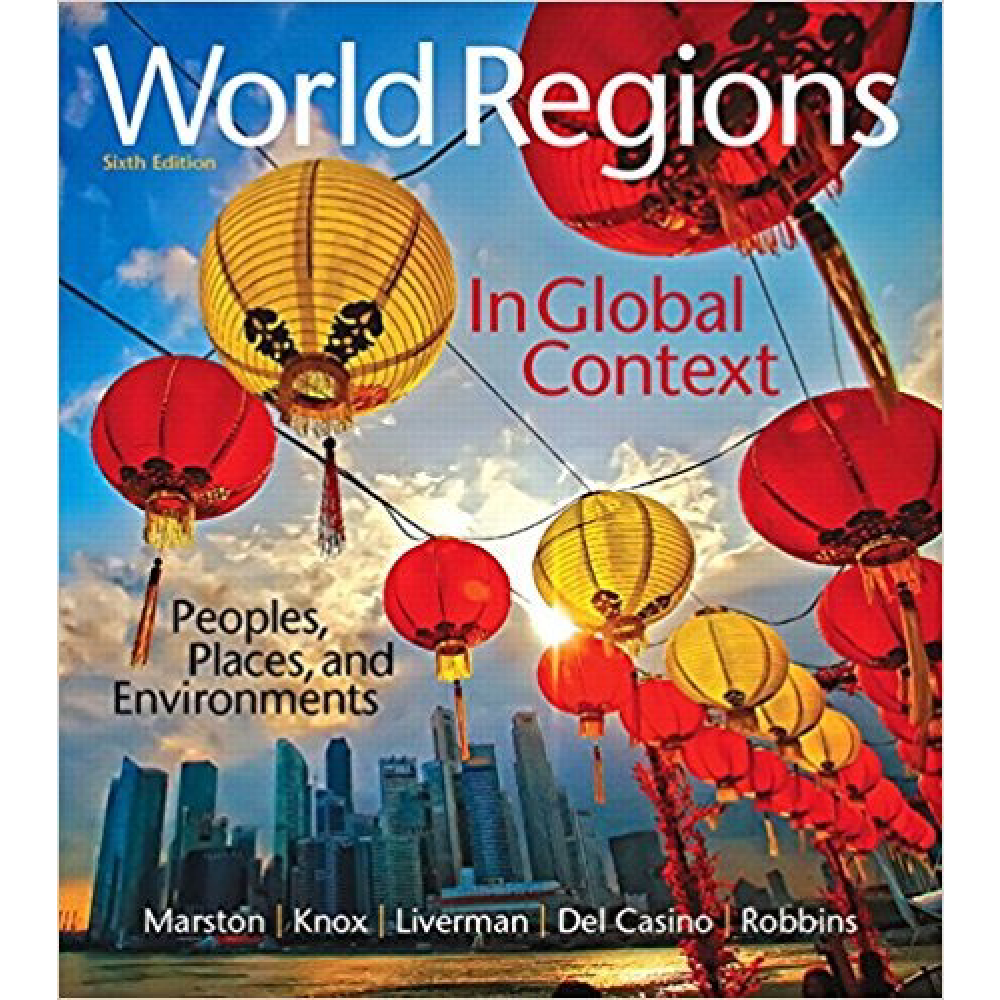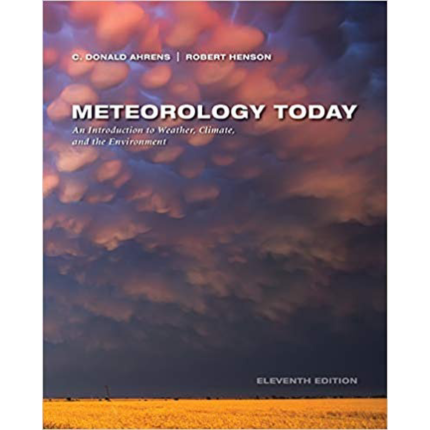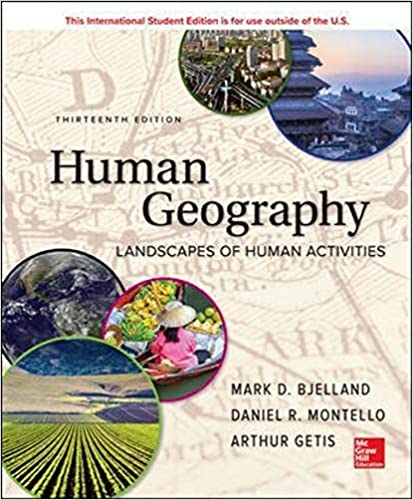Chapter 11 Oceania
1) Which type of mammal lays eggs?
A) marsupial
B) monotremes
C) eucalyptus
D) placental
E) none of the above
Answer: B
Diff: 1
Section: Environment, Society, and Sustainability
Geog. Standard: N8 The characteristics and spatial distribution of ecosystems and biomes of Earth’s surface
Bloom’s Taxonomy: Remembering/Understanding
Global Sci Out: G2 Demonstrate the ability to think critically and employ critical thinking skills.
Learning Obj: 11.16 Identify factors that produced the distribution of species and biodiversity of Pacific Island ecosystems.
2) Two-thirds of Australia is occupied by this mass of old shield rocks.
A) Eastern Highlands
B) Interior Lowland
C) Western Plateau
D) Great Karoo
E) none of the above
Answer: C
Diff: 2
Section: Environment, Society, and Sustainability
Geog. Standard: N4 The physical and human characteristics of places
Bloom’s Taxonomy: Remembering/Understanding
Global Sci Out: G7 Demonstrate the ability to make connections between concepts across Geography.
Learning Obj: 11.8 Summarize the characteristics of Australia’s three main physiographic regions.
3) Which of the following physical regions of Australia is the remnant of an old folded mountain range with a steep escarpment on the eastern flanks?
A) Eastern Highlands
B) Interior Lowland
C) Western Plateau
D) Great Karoo
E) none of the above
Answer: A
Diff: 2
Section: Environment, Society, and Sustainability
Geog. Standard: N7 The physical process that shape the patterns of Earth’s surface
Bloom’s Taxonomy: Remembering/Understanding
Global Sci Out: G2 Demonstrate the ability to think critically and employ critical thinking skills.
Learning Obj: 11.8 Summarize the characteristics of Australia’s three main physiographic regions.
4) What New Zealand species was hunted to extinction by the Maori?
A) kauri
B) beech
C) kiwi
D) moa
E) none of the above
Answer: D
Diff: 2
Section: Environment, Society, and Sustainability
Geog. Standard: N8 The characteristics and spatial distribution of ecosystems and biomes of Earth’s surface
Bloom’s Taxonomy: Remembering/Understanding
Global Sci Out: G2 Demonstrate the ability to think critically and employ critical thinking skills.
Learning Obj: 11.15 Describe New Zealand’s ecosystems and how they were modified by Maoris and Europeans.
5) The climate of ________ is dominated by the westerly wind belt and frequent rain storms.
A) Australia
B) New Zealand
C) New Guinea
D) Polynesia
E) none of the above
Answer: B
Diff: 2
Section: Environment, Society, and Sustainability
Geog. Standard: N7 The physical process that shape the patterns of Earth’s surface
Bloom’s Taxonomy: Remembering/Understanding
Global Sci Out: G7 Demonstrate the ability to make connections between concepts across Geography.
Learning Obj: 11.3 Describe New Zealand’s climates and the geographic factors that influence them.
6) All of these are islands in the Micronesian group except:
A) Fiji
B) Nauru
C) Kiribati
D) Palau
E) Guam
Answer: A
Diff: 2
Section: Environment, Society, and Sustainability
Geog. Standard: N3 How to analyze the spatial organization of people, places, and environments on Earth’s surface
Bloom’s Taxonomy: Remembering/Understanding
Global Sci Out: G2 Demonstrate the ability to think critically and employ critical thinking skills.
Learning Obj: 11.1 Distinguish Melanesia, Micronesia, and Polynesia in terms of the main islands and island groups in each.
7) The Hawai’ian Islands, ethnically and linguistically, are considered part of this island group.
A) Indonesia
B) Melanesia
C) Micronesia
D) Polynesia
E) Mesonesia
Answer: D
Diff: 2
Section: Environment, Society, and Sustainability
Geog. Standard: N3 How to analyze the spatial organization of people, places, and environments on Earth’s surface
Bloom’s Taxonomy: Remembering/Understanding
Global Sci Out: G2 Demonstrate the ability to think critically and employ critical thinking skills.
Learning Obj: 11.1 Distinguish Melanesia, Micronesia, and Polynesia in terms of the main islands and island groups in each.
8) Which of the following are threats to the Great Barrier Reef?
A) coral bleaching
B) sediment pollution
C) shipping accidents
D) large net fishing
E) all of the above
Answer: E
Diff: 2
Section: Environment, Society, and Sustainability
Geog. Standard: N14 How human actions modify the physical environment
Bloom’s Taxonomy: Remembering/Understanding
Global Sci Out: G2 Demonstrate the ability to think critically and employ critical thinking skills.
Learning Obj: 11.7 Identify the likely effects of climate change on Oceania and Antarctica, including Australia’s efforts to reduce its greenhouse emissions.
9) Australia is one of the most arid places on earth, with two-thirds of the country receiving less than ________ inches of rainfall annually.
A) 30
B) 20
C) 35
D) 40
E) 50
Answer: B
Diff: 2
Section: Environment, Society, and Sustainability
Geog. Standard: N7 The physical process that shape the patterns of Earth’s surface
Bloom’s Taxonomy: Remembering/Understanding
Global Sci Out: G7 Demonstrate the ability to make connections between concepts across Geography.
Learning Obj: 11.10 Analyze the processes that formed Australia’s desert landscapes and their significance for the Aborigenes.
10) What are the dry interior drainage basins often called?
A) Desert Pavement
B) Playas
C) Uluru
D) Olga
E) none of the above
Answer: B
Diff: 3
Section: Environment, Society, and Sustainability
Geog. Standard: N4 The physical and human characteristics of places
Bloom’s Taxonomy: Remembering/Understanding
Global Sci Out: G7 Demonstrate the ability to make connections between concepts across Geography.
Learning Obj: 11.10 Analyze the processes that formed Australia’s desert landscapes and their significance for the Aborigenes.













Reviews
There are no reviews yet.